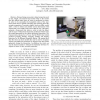Free Online Productivity Tools
i2Speak
i2Symbol
i2OCR
iTex2Img
iWeb2Print
iWeb2Shot
i2Type
iPdf2Split
iPdf2Merge
i2Bopomofo
i2Arabic
i2Style
i2Image
i2PDF
iLatex2Rtf
Sci2ools
ICRA
2009
IEEE
2009
IEEE
Interactive learning of the acoustic properties of household objects
— Human beings can perceive object properties such as size, weight, and material type based solely on the sounds that the objects make when an action is performed on them. In order to be successful, the household robots of the near future must also be capable of learning and reasoning about the acoustic properties of everyday objects. Such an ability would allow a robot to detect and classify various interactions with objects that occur outside of the robot’s field of view. This paper presents a framework that allows a robot to infer the object and the type of behavioral interaction performed with it from the sounds generated by the object during the interaction. The framework is evaluated on a 7-d.o.f. Barrett WAM robot which performs grasping, shaking, dropping, pushing and tapping behaviors on 36 different household objects. The results show that the robot can learn models that can be used to recognize objects (and behaviors performed on objects) from the sounds generated durin...
| Added | 23 May 2010 |
| Updated | 23 May 2010 |
| Type | Conference |
| Year | 2009 |
| Where | ICRA |
| Authors | Jivko Sinapov, Mark Wiemer, Alexander Stoytchev |
Comments (0)

